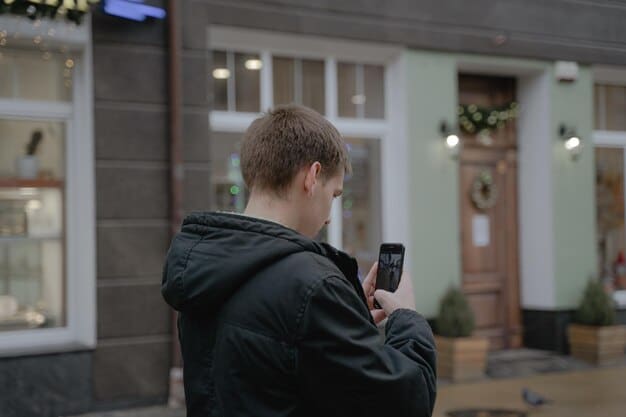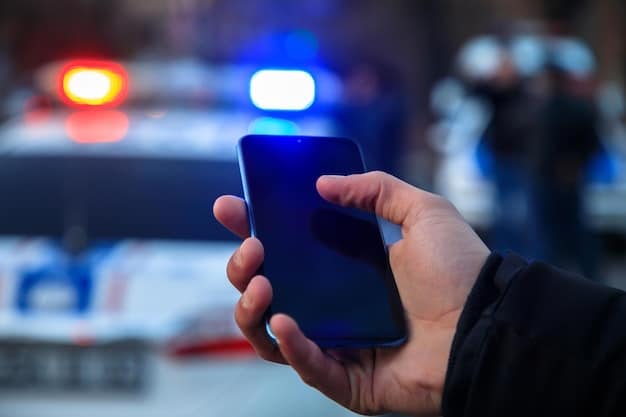How to Report Suspicious Activity: Protecting Your Neighborhood

Reporting suspicious activity is crucial for maintaining neighborhood safety; promptly contacting local law enforcement or using online reporting tools can significantly contribute to preventing crime and ensuring community well-being.
Your neighborhood’s safety is a shared responsibility. Knowing how to report suspicious activity: A guide to protecting your neighborhood effectively can make a significant difference in preventing crime and ensuring the well-being of your community. This guide provides essential steps and resources to help you take action.
Understanding Suspicious Activity
Identifying suspicious activity is the first step towards ensuring neighborhood safety. Recognizing what constitutes suspicious behavior can empower you and your neighbors to report incidents that may warrant attention from law enforcement.
What Qualifies as Suspicious?
Suspicious activity isn’t always illegal, but it’s behavior that seems out of place or unusual for your neighborhood. Being aware of these signs helps you stay vigilant.
- Unusual Loitering: Individuals lingering without apparent purpose, particularly in areas with homes or businesses.
- Strange Vehicles: Vehicles driving slowly through the neighborhood repeatedly, sometimes without license plates or with obscured views.
- Unexplained Noises: Alarms sounding for extended periods, breaking glass, or suspicious shouting coming from a building.
- Signs of Forced Entry: Broken windows, damaged doors, or any indication someone has attempted to enter a property without permission.
Staying informed and alert enhances your ability to discern potential threats and protect your community.
The Importance of Reporting
Reporting suspicious activity can help prevent potential crimes and ensure a safer environment for everyone. Timely reporting allows law enforcement to investigate and take appropriate action if necessary.

How to Report Suspicious Activity Effectively
When you observe something suspicious, reporting it quickly and accurately is essential. Understanding the proper channels and the type of information to provide can significantly aid law enforcement’s response.
Immediate Steps to Take
The first moments after spotting suspicious activity are crucial. Acting quickly and safely can greatly assist authorities.
- Stay Calm: Avoid panicking and assess the situation carefully.
- Observe Details: Note specific details such as physical descriptions, clothing, vehicle types, and license plates.
- Do Not Intervene: Do not confront the individuals or put yourself in harm’s way. Your safety is the priority.
- Contact Authorities: Call your local law enforcement immediately or use their non-emergency number for non-urgent situations.
Providing Accurate Information
When reporting, clear and precise information is invaluable. The more details you can provide, the better law enforcement can assess and respond to the situation.
Report the following information when possible:
- Description of Individuals: Including gender, race, age, height, weight, hair color, and any distinguishing marks or features.
- Description of Vehicles: Note the make, model, color, license plate number, and any unique characteristics.
- Location and Time: Specify the exact location of the activity and the time it occurred.
- Nature of the Activity: Clearly explain what you observed and why it seemed suspicious.
Reporting Methods: Phone, Online, and Apps
There are several ways to report suspicious activity, each with its advantages. Knowing your options ensures you can choose the method that best suits the situation.
Calling Local Law Enforcement
Calling the police is often the quickest way to report urgent or ongoing suspicious activity. Use 911 for emergencies and the non-emergency number for less urgent situations.
When calling, be prepared to provide:
- Your Name and Location: Always start by giving your name and the exact location of the incident.
- Details of the Activity: Clearly describe what you saw and why it was suspicious.
- Follow Instructions: Listen carefully to the dispatcher’s instructions and answer their questions accurately.
Remember, stay on the line until the dispatcher tells you it’s okay to hang up.
Utilizing Online Reporting Tools
Many law enforcement agencies now offer online reporting tools for non-emergency situations. These platforms allow you to submit detailed reports with photos and videos.
Benefits of online reporting include:
- Convenience: You can report incidents at any time, from any location.
- Detailed Reporting: You can include photos, videos, and comprehensive descriptions.
- Documentation: You have a written record of your report.
Check your local law enforcement website for online reporting options.

Community Watch Programs and Collaboration
Community watch programs are a powerful tool for fostering neighborhood safety. These initiatives encourage neighbors to work together to spot and report suspicious activity.
Joining a Neighborhood Watch
Participating in a neighborhood watch program can enhance vigilance and improve communication within your community. These programs often involve regular meetings, training sessions, and coordinated patrols.
Key benefits of joining a neighborhood watch:
- Increased Awareness: Learn to recognize and report suspicious activities specific to your area.
- Improved Communication: Establish direct lines of communication with neighbors and local law enforcement.
- Deterrent Effect: The presence of an active neighborhood watch can deter potential criminals.
Contact your local law enforcement to find existing neighborhood watch programs or to start one in your area.
Collaborating with Local Law Enforcement
Building a strong relationship with your local police department is crucial for maintaining neighborhood safety. Collaborate with law enforcement by attending community meetings, sharing information, and supporting their efforts.
Ways to collaborate effectively:
- Attend Community Policing Events: Participate in events where you can meet and interact with local officers.
- Share Information: Provide any relevant information or insights you have about crime trends in your area.
- Support Law Enforcement Initiatives: Advocate for resources and programs that enhance public safety.
Effective collaboration fosters trust and mutual respect between the community and law enforcement.
The Role of Technology in Reporting and Prevention
Technology can play a significant role in preventing crime and enhancing neighborhood safety. From security cameras to social media groups, various tools can aid in reporting and addressing suspicious activity.
Home Security Systems
Installing home security systems can deter potential criminals and provide valuable evidence if a crime occurs. These systems often include alarms, surveillance cameras, and monitoring services.
Consider these benefits:
- Deterrence: Visible security systems can deter potential intruders.
- Surveillance: Cameras can capture footage of suspicious activity.
- Rapid Response: Alarms can alert authorities quickly in case of a break-in.
Evaluate your needs and budget when choosing a home security system.
Using Social Media Responsibly
Social media can be a powerful tool for sharing information and coordinating community efforts. However, it’s essential to use these platforms responsibly and avoid spreading misinformation.
Guidelines for using social media:
- Verify Information: Always verify information before sharing it to avoid spreading false rumors.
- Respect Privacy: Avoid posting photos or videos that could violate someone’s privacy.
- Report to Authorities First: Always report suspicious activity to law enforcement before posting it on social media.
Responsible social media use can enhance community awareness and support law enforcement efforts.
Safety Tips for Observing and Reporting
Your safety is paramount when observing and reporting suspicious activity. Taking precautions can protect you from harm and ensure you can provide accurate information to the authorities.
Prioritizing Personal Safety
When you notice something suspicious, your safety should be your top priority. Avoid any actions that could put you in danger.
Key safety tips:
- Do Not Approach: Never approach or confront individuals engaged in suspicious activity.
- Observe from a Safe Distance: Maintain a safe distance and observe from a secure location.
- Avoid Direct Eye Contact: Refrain from making direct eye contact with suspicious individuals.
Prioritizing your safety ensures you can report effectively without putting yourself at risk.
Avoiding False Accusations
It’s crucial to report suspicious activity based on facts and observations rather than assumptions or biases. False accusations can have serious consequences for innocent individuals.
Guidelines for avoiding false accusations:
- Report Facts: Stick to the facts and avoid speculation or emotional interpretations.
- Avoid Stereotyping: Do not make assumptions based on someone’s race, ethnicity, or appearance.
- Respect Civil Rights: Remember that everyone has the right to be treated fairly and with respect.
Accurate and objective reporting is essential for maintaining trust and fairness in your community.
| Key Point | Brief Description |
|---|---|
| 🧐 Recognize Suspicious Activity | Identify behaviors that seem out of place or unusual in your neighborhood. |
| 📞 Report Promptly to Authorities | Contact the police or use online reporting tools for non-emergencies. |
| 🤝 Join Community Watch Programs | Collaborate with neighbors and local law enforcement to enhance safety. |
| 🛡️ Prioritize Personal Safety | Observe from a safe distance and avoid direct confrontation. |
Frequently Asked Questions (FAQ)
▼
Immediately call 911 to report the crime in progress. Provide your location and a detailed description of the individual to the dispatcher.
▼
Look for vehicles driving slowly and repeatedly in the same area, especially if they have obscured license plates or no plates at all. Report any unusual activity to the non-emergency police line.
▼
It’s always better to be safe than sorry. If something seems out of place or makes you uncomfortable, report it. Law enforcement can assess the situation.
▼
Yes, most law enforcement agencies allow anonymous reporting. However, providing your contact information may help them gather additional information if needed.
▼
A community watch program is a group of neighbors who work together to spot and report suspicious activity, enhancing community safety and communication with local law enforcement.
Conclusion
Knowing how to report suspicious activity: A guide to protecting your neighborhood and acting on it is a critical component of ensuring community safety. By staying informed, collaborating with local law enforcement, and prioritizing personal safety, you can contribute to a safer, more secure environment for everyone.





